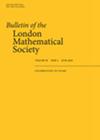More unit distances in arbitrary norms
IF 0.9
3区 数学
Q2 MATHEMATICS
引用次数: 0
Abstract
For and any norm on , we prove that there exists a set of points that spans at least unit distances under this norm for every . This matches the upper bound recently proved by Alon, Bucić, and Sauermann for typical norms (i.e., norms lying in a comeagre set). We also show that for and a typical norm on , the unit distance graph of this norm contains a copy of for all .


任意范数中更多的单位距离
对于d小于2 $d\geqslant 2$和R d $\mathbb {R}^d$上的任何规范,我们证明了存在一个n个$n$点的集合,它张成至少(d 2−o (1))) n log 2 n $(\tfrac{d}{2}-o(1))n\log _2n$在这个范数下的单位距离对于每一个n $n$。这与最近由Alon, buciki和Sauermann证明的典型范数(即,位于一个趋同集中的范数)的上界相匹配。我们还显示,对于d小于3 $d\geqslant 3$和R d $\mathbb {R}^d$上的典型范数,该范数的单位距离图包含K d的副本,M $K_{d,m}$代表所有M $m$。
本文章由计算机程序翻译,如有差异,请以英文原文为准。
求助全文
约1分钟内获得全文
求助全文
来源期刊
CiteScore
1.90
自引率
0.00%
发文量
198
审稿时长
4-8 weeks
期刊介绍:
Published by Oxford University Press prior to January 2017: http://blms.oxfordjournals.org/

 求助内容:
求助内容: 应助结果提醒方式:
应助结果提醒方式:


